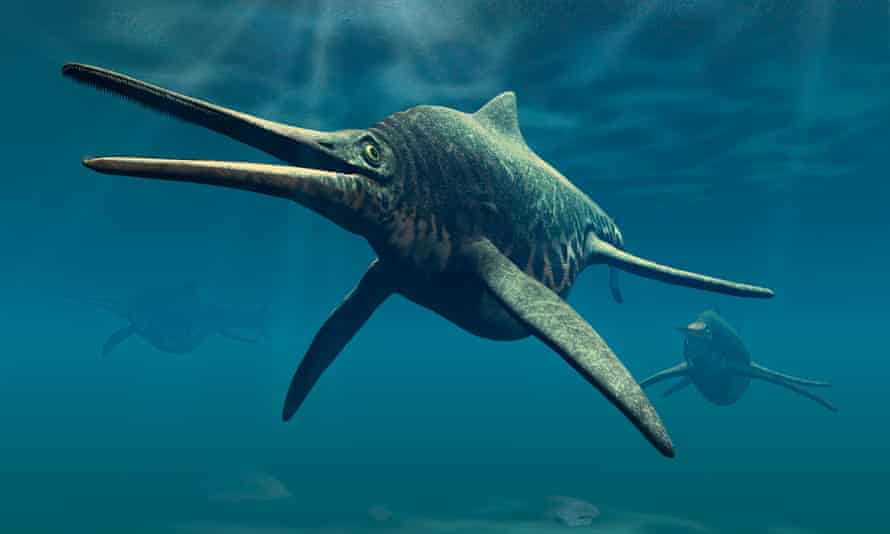The remains of a huge sea creature with enormous teeth that could have helped it capture giant squid have been found in the Swiss Alps.
Ichthyosaurs were large marine reptiles with an elongated, snakey shape. They first emerged after the end of the Permian extinction, an event also known as the “great dying”, which occurred about 250m years ago and which wiped out more than two-thirds of species on land and 96% of marine species.
The toothy beast is one of three giant ichthyosaurs discovered in the Swiss Alps and is thought to have lived during the late Triassic period, about 205m years ago – potentially making them some of the last such behemoths.
The team said the findings helped resolve the conundrum of whether giant ichthyosaurs, like some smaller species of the creatures, had teeth.
Prof Martin Sander, of the University of Bonn, a co-author of the study, said: “It’s all very, very scanty evidence. We have these ghosts swimming in the late Triassic oceans for tens of millions of years, and we don’t know what they look like. It’s an embarrassment for palaeontology.
“For a while we thought they had teeth. Then we thought, well, we never find any teeth. Now we have the tooth of a giant and a giant tooth. So some of them have teeth.”
Writing in the Journal of Vertebrate Paleontology the team describe how they discovered fossils from three giant ichthyosaurs at different sites in the Kössen Formation between 1976 and 1990.
A fossil from one of the beasts was an incomplete tooth 10cm in length. The team found an enormous vertebra and rib fragments relating to another. The fossils of the third included seven large vertebrae. Sander said none of the remains appeared to be of known species of ichthyosaur.
The team say the tooth, which lacks most of its crown, is only the second to have come from a giant ichthyosaur and is the largest ever found for such a creature, surpassing those of a species known as Himalayasaurus, which was discovered in China and is thought to have had a body length of about 15 metres.
“Ichthyosaurs have a very characteristic tooth structure that’s visible in the root and also in the crown,” said Sander, adding that the toothy giant discovered in the Alps probably would have eaten smaller ichthyosaurs and giant squid.
Sander said one of the creatures appeared to have been about the same size as Himalayasaurus, while the other two, including the toothy beast, were probably similar in size to the giant ichthyosaur Shastasaurus, a creature found previously in British Columbia and that was about 21 metres long – around two doubledecker bus lengths. “That skeleton had vertebrae that are the same diameter as the ones from the Alps,” said Sander.
But they are not the largest ichthyosaurs known to have lived. Among other finds, a toothless jawbone discovered in the Bristol channel is thought to have belonged to an ichthyosaur that was about 26 metres long.

While ichthyosaurs roamed around the oceans, the newly reported remains were laid down in what was once a lagoon, suggesting the beasts went into shallow waters. “It’s kind of the same problem when you get a sperm whale in the North Sea,” said Sander.
Dr Ben Moon, a palaeontologist at the University of Bristol who was not involved in the work, said it was possible the creatures might have entered shallow waters to mate or give birth. He said the new report was exciting as there were few fossils of giant ichthyosaurs.
Dr Nick Fraser, a palaeontologist at National Museums Scotland, said it was difficult to determine the size of a giant ichthyosaur based on a tooth alonebut that the finds shed new light on the reptiles.
“Until now we have suspected that most of the largest ichthyosaurs were toothless and were suction feeders,” he said, adding that the size of the newly reported tooth was stunning.
“The owner of this tooth was not to be messed with,” said Fraser. “Along with remains of vertebrae and ribs, here is really concrete evidence that, in the past, Triassic waters sheltered some truly massive ocean-going reptiles, possibly as large as the living blue whale, and some likely had huge jaws armed with robust teeth.”